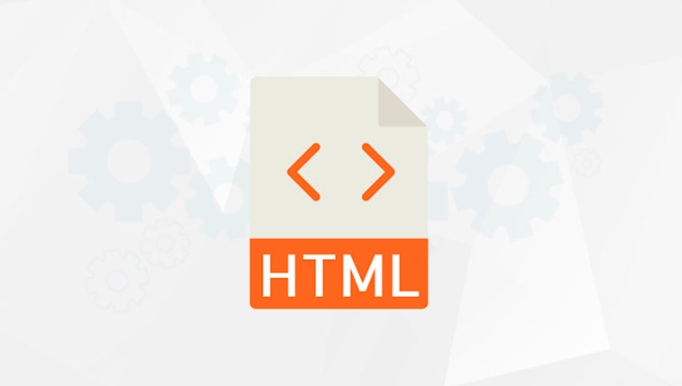If you want to draw pictures, make animations or even develop mini-games on web pages, you can use the

If you want to draw pictures, make animations or even develop mini-games on web pages, the HTML5 <canvas></canvas> tag is a very practical tool. It itself is just a blank canvas, and the real magic lies in using JavaScript to control how and what it draws.

Create Canvas elements
First, add a <canvas></canvas> tag to HTML:
<canvas id="myCanvas" width="500" height="300"></canvas>
This tag is transparent by default, has no content, and does not come with any drawing capabilities. You can define its dimensions by setting width and height properties. If not set, the default size (usually 300x150) is used.

Then get the element in JavaScript and get the drawing context:
const canvas = document.getElementById('myCanvas'); const ctx = canvas.getContext('2d');
ctx is the object you use to "draw", and almost all operations revolve around it.

Draw basic graphics
Once you have the context, you can start drawing things. For example, drawing a simple rectangle:
ctx.fillStyle = 'blue'; ctx.fillRect(50, 50, 100, 100);
This code sets the fill color to blue, and then starts from coordinates (50, 50), and draws a rectangle of 100 pixels in width and height.
You can also draw borders, circles, lines, etc. For example, draw a red circle:
ctx.beginPath(); ctx.arc(200, 150, 40, 0, Math.PI * 2); ctx.fillStyle = 'red'; ctx.fill(); ctx.closePath();
-
beginPath()means starting a new path; -
arc(x, y, radius, startAngle, endAngle)is the method of drawing circles; -
fill()fills the path; -
closePath()closes the path.
How to do animation and interaction?
Canvas can not only draw statically, but also create animation effects. A common practice is to constantly clear the canvas and repaint the contents of the painting. For example, do an animation of a small ball moving:
let x = 0;
function draw() {
ctx.clearRect(0, 0, canvas.width, canvas.height); // Clear canvas ctx.beginPath();
ctx.arc(x, 150, 20, 0, Math.PI * 2);
ctx.fillStyle = 'green';
ctx.fill();
x = 2;
if (x > canvas.width) x = 0; // loop requestAnimationFrame(draw); // continuously draw}
draw();This will enable the effect of a small ball moving back and forth on the screen. You can also interact with mouse events or touch events, such as clicking on the canvas to change the color, dragging animals, etc.
Notes and FAQs
- Resolution problem : If the image is blurred after the page is scaled, it may be because the CSS sets the canvas size but does not adjust it to the actual pixels. It is recommended to keep
canvas.widthandcanvas.heightmatching the display size. - Performance optimization : Try to update only the changing part when repainting frequently, not the entire canvas.
- Browser compatibility : Modern browsers basically support Canvas, but there may be problems on older versions of IE.
- Export picture : You can use
canvas.toDataURL()method to save the current picture as a picture.
Basically that's it. Canvas doesn't seem complicated, but there are many details, especially when it comes to animation, interaction or a lot of graphics processing, you need to practice more.
The above is the detailed content of How to use HTML5 canvas?. For more information, please follow other related articles on the PHP Chinese website!

Hot AI Tools

Undress AI Tool
Undress images for free

Undresser.AI Undress
AI-powered app for creating realistic nude photos

AI Clothes Remover
Online AI tool for removing clothes from photos.

Clothoff.io
AI clothes remover

Video Face Swap
Swap faces in any video effortlessly with our completely free AI face swap tool!

Hot Article

Hot Tools

Notepad++7.3.1
Easy-to-use and free code editor

SublimeText3 Chinese version
Chinese version, very easy to use

Zend Studio 13.0.1
Powerful PHP integrated development environment

Dreamweaver CS6
Visual web development tools

SublimeText3 Mac version
God-level code editing software (SublimeText3)
 Adding drag and drop functionality using the HTML5 Drag and Drop API.
Jul 05, 2025 am 02:43 AM
Adding drag and drop functionality using the HTML5 Drag and Drop API.
Jul 05, 2025 am 02:43 AM
The way to add drag and drop functionality to a web page is to use HTML5's DragandDrop API, which is natively supported without additional libraries. The specific steps are as follows: 1. Set the element draggable="true" to enable drag; 2. Listen to dragstart, dragover, drop and dragend events; 3. Set data in dragstart, block default behavior in dragover, and handle logic in drop. In addition, element movement can be achieved through appendChild and file upload can be achieved through e.dataTransfer.files. Note: preventDefault must be called
 Using ARIA attributes with HTML5 semantic elements for accessibility
Jul 07, 2025 am 02:54 AM
Using ARIA attributes with HTML5 semantic elements for accessibility
Jul 07, 2025 am 02:54 AM
The reason why ARIA and HTML5 semantic tags are needed is that although HTML5 semantic elements have accessibility meanings, ARIA can supplement semantics and enhance auxiliary technology recognition capabilities. For example, when legacy browsers lack support, components without native tags (such as modal boxes), and state updates need to be dynamically updated, ARIA provides finer granular control. HTML5 elements such as nav, main, aside correspond to ARIArole by default, and do not need to be added manually unless the default behavior needs to be overridden. The situations where ARIA should be added include: 1. Supplement the missing status information, such as using aria-expanded to represent the button expansion/collapse status; 2. Add semantic roles to non-semantic tags, such as using div role to implement tabs and match them
 Securing HTML5 web applications against common vulnerabilities
Jul 05, 2025 am 02:48 AM
Securing HTML5 web applications against common vulnerabilities
Jul 05, 2025 am 02:48 AM
The security risks of HTML5 applications need to be paid attention to in front-end development, mainly including XSS attacks, interface security and third-party library risks. 1. Prevent XSS: Escape user input, use textContent, CSP header, input verification, avoid eval() and direct execution of JSON; 2. Protect interface: Use CSRFToken, SameSiteCookie policies, request frequency limits, and sensitive information to encrypt transmission; 3. Secure use of third-party libraries: periodic audit dependencies, use stable versions, reduce external resources, enable SRI verification, ensure that security lines have been built from the early stage of development.
 Integrating CSS and JavaScript effectively with HTML5 structure.
Jul 12, 2025 am 03:01 AM
Integrating CSS and JavaScript effectively with HTML5 structure.
Jul 12, 2025 am 03:01 AM
HTML5, CSS and JavaScript should be efficiently combined with semantic tags, reasonable loading order and decoupling design. 1. Use HTML5 semantic tags, such as improving structural clarity and maintainability, which is conducive to SEO and barrier-free access; 2. CSS should be placed in, use external files and split by module to avoid inline styles and delayed loading problems; 3. JavaScript is recommended to be introduced in front, and use defer or async to load asynchronously to avoid blocking rendering; 4. Reduce strong dependence between the three, drive behavior through data-* attributes and class name control status, and improve collaboration efficiency through unified naming specifications. These methods can effectively optimize page performance and collaborate with teams.
 Using HTML5 Semantic Elements for Page Structure
Jul 07, 2025 am 02:53 AM
Using HTML5 Semantic Elements for Page Structure
Jul 07, 2025 am 02:53 AM
Using HTML5 semantic tags can improve web structure clarity, accessibility and SEO effects. 1. Semantic tags such as,,,, and make it easier for the machine to understand the page content; 2. Each tag has a clear purpose: used in the top area, wrap navigation links, include core content, display independent articles, group relevant content, place sidebars, and display bottom information; 3. Avoid abuse when using it, ensure that only one per page, avoid excessive nesting, reasonable use and in blocks. Mastering these key points can make the web page structure more standardized and practical.
 HTML5 video not playing in Chrome
Jul 10, 2025 am 11:20 AM
HTML5 video not playing in Chrome
Jul 10, 2025 am 11:20 AM
Common reasons why HTML5 videos don't play in Chrome include format compatibility, autoplay policy, path or MIME type errors, and browser extension interference. 1. Videos should be given priority to using MP4 (H.264) format, or provide multiple tags to adapt to different browsers; 2. Automatic playback requires adding muted attributes or triggering .play() with JavaScript after user interaction; 3. Check whether the file path is correct and ensure that the server is configured with the correct MIME type. Local testing is recommended to use a development server; 4. Ad blocking plug-in or privacy mode may prevent loading, so you can try to disable the plug-in, replace the traceless window or update the browser version to solve the problem.
 Embedding video content using the HTML5 `` tag.
Jul 07, 2025 am 02:47 AM
Embedding video content using the HTML5 `` tag.
Jul 07, 2025 am 02:47 AM
Embed web videos using HTML5 tags, supports multi-format compatibility, custom controls and responsive design. 1. Basic usage: add tags and set src and controls attributes to realize playback functions; 2. Support multi-formats: introduce different formats such as MP4, WebM, Ogg, etc. through tags to improve browser compatibility; 3. Custom appearance and behavior: hide default controls and implement style adjustment and interactive logic through CSS and JavaScript; 4. Pay attention to details: Set muted and autoplay to achieve automatic playback, use preload to control loading strategies, combine width and max-width to achieve responsive layout, and use add subtitles to enhance accessibility.
 Drawing Graphics and Animations using HTML5 Canvas
Jul 05, 2025 am 01:09 AM
Drawing Graphics and Animations using HTML5 Canvas
Jul 05, 2025 am 01:09 AM
HTML5Canvas is suitable for web graphics and animations, and uses JavaScript to operate context drawing; ① First add canvas tags to HTML and get 2D context; ② Use fillRect, arc and other methods to draw graphics; ③ Animation is achieved by clearing the canvas, redrawing, and requestAnimationFrame loops; ④ Complex functions require manual processing of event detection, image drawing and object encapsulation.






